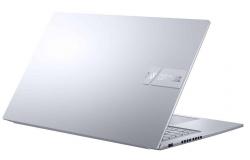The (Windows) PC industry had fallen into a bit of a rut over the past decade. Microsoft and its OEM partners were shipping new devices every year. And most of the time the improvements came from new Intel processors. And if you buy this year’s Surface, you get slightly better battery life and a modest performance boost over last year’s model. And that’s a shame. Why?
Because this Copilot+ PC, which has just been launched, has great potential. Of course, it runs under Windows 11. But under the hood we find a new engine: Qualcomm’s Snapdragon X processor, based on Arm technology.
My Surface Pro 11 (yes I know its official name is “Surface Pro, 11th Edition”, but let’s keep it simple) arrived last week. I deliberately ordered the cheapest configuration. And I had no idea what to expect. Yes she should have better battery life than an Intel-based alternative. And all preliminary benchmarks suggested it would deliver impressive performance. But you have to see it to believe it, right?
Surface Pro technical specifications
- Processors: Snapdragon X Plus (10 cores) with LCD display and Snapdragon X Elite (12 cores) with OLED display
- NPU: Qualcomm Hexagon with 45 trillion operations per second
- Graphics chip: Qualcomm Adreno
- Memory options: RAM LPDDR5x de 16 Go ou 32 Go
- Storage options: Removable SSD (4th generation SSD): 256GB, 512GB, 1TB32
- Display : Surface Pro with OLED display: 13-inch touchscreen and resolution: 2880 × 1920 (267 PPI), Surface Pro with LCD display: 13-inch touchscreen and resolution: 2880 × 1920 (267 PPI)
- Battery life : Up to 14 hours of local video playback, up to 10 hours of web browsing battery life
- Dimensions : 287 mmx209 mmx9,3 mm
- Weight : 895 g
- Video/cameras: Surface Studio Quad HD front camera, Quad HD 1440p ultra-wide-angle camera, 10-megapixel Ultra HD rear camera
- Connexions (ports) : 2 ports USB-C/USB4, DisplayPort 1.4a, Wi-Fi 7
After a full week of testing, I can say this without reservation. This machine is absolutely brilliant.
My original intention was to use the new Surface Pro as a secondary laptop, while keeping my Dell Precision workstation on my desk for daily tasks. Well, I now use the new Surface Pro as my main computer. How did I get here? Let’s take a closer look.
The Surface Pro Copilot+ PC experience is familiar
The arrival of the Qualcomm processor is a radical change in the Windows ecosystem. But the 2-in-1 Surface Pro 11 doesn’t look that different from its predecessors. In fact, it’s almost indistinguishable from the Intel-based Surface Pro 9. The refined edges of the screens of both devices are practically the same size. The new device, which weighs 895 g, has the same weight as the Surface Pro 9. And a few grams more than the Surface Pro place on the Surface Pro 11, exactly as expected.
And on the OS side, well… it’s Windows 11, which runs the same on an Arm-based PC as it does on a device powered by an Intel processor.
After a three-hour Zoom call the other day, the chassis was barely warm
The big difference is that this new generation device remains extremely cool and quiet. After a three-hour Zoom call the other day, the chassis was barely warm. On an Intel processor-based machine, it would have been hot. There’s also a fan inside the Surface Pro 11. But I never heard it running, even in the most demanding conditions. The machine is extremely responsive, unlike the Surface Pro X at times. If you have used a MacBook Air equipped with M2 technology, this feeling will be familiar to you.
Of course, this new device also embodies everything you like and/or don’t like about the Surface Pro’s design. If you’re expecting a radical change, such as suddenly making the kickstand comfortable on your lap, you’ll be disappointed.
Surface Pro Copilot+ PC battery life is great
If the Arm architecture has a major advantage, it is battery life. The Surface Pro X performed very well on this point. But at the expense of performance. This latest generation, on the other hand, impressively increases battery life, and does so without any compromise in speed or responsiveness.
It is still a little too early to say definitively about the duration for which this Surface Pro will allow me to work in complete autonomy. The first week with a new device is never typical, as it involves a lot of downloads, installations, configurations and fiddling that probably won’t be regular.
But these usage figures, from a report generated by the Windows command Powercfg /batteryreportspeak for themselves.
In real-world use, the Surface Pro 11’s battery lasts twice as long as an Intel-based equivalent. Screenshot by Ed Bott/ZDNET
With an average of over 10 hours of real-world battery life, this Surface Pro is capable of running twice as long as my Intel-based Surface Pro 9. It’s also at least as long as the MacBook Air M2.
Compatibility is good but not perfect
For these Snapdragon X PCs, autonomy is an undeniable success. But when it comes to compatibility, it’s more complicated.
Microsoft has been developing Windows on Arm for over ten years. And it’s remarkable how well most software runs on an Arm-based PC. If you do most of your work in a web browser and in Microsoft Office, you may never notice the difference. But there are still some imperfections. And you can expect compatibility issues, especially when using older hardware or software that requires system drivers.
On this PC, every preinstalled Microsoft program is, naturally, compiled to run in native Arm64 code. This includes the Edge browser, Microsoft 365 software, and every Windows utility imaginable, from PowerShell to Registry Editor to Calculator. Even the semi-official PowerToys collection installs in Arm64 mode. I installed a large selection of web apps that run in the Arm64 Edge environment. And they all worked well.
Kyle Kucharski/ZDNET
A fairly present 64-bit ecosystem
Software written for Intel x86 machines generally installs smoothly in the Windows on Arm emulation layer. And the performance of the programs I tried, including my favorite screenshot utility, SnagIt, was unaffected.
Many third-party developers have gone to the trouble of recompiling their software for Arm64. And if you can find them, this is definitely the option to go for. But you might have to dig a little deeper.
The default download for VLC Media Player, for example, is a 64-bit x86 version. But nightly builds compiled for Arm64 machines are also available. Likewise, the normal download options for 1Password will get you the x86 version, which has no issues. But there is a preview of the Arm64 version if you know where to look.
Google and Adobe can do better
Then it gets trickier. I’m not sure what to make of Adobe. The company tweeted earlier this year that it was “excited to announce that your favorite Adobe software is coming to Copilot+ PCs.” What does that mean? Photoshop has been available in Arm64 for three years, albeit with significant limitations. But I can’t find a native Arm version of Acrobat. Maybe Adobe just means that the x86 versions are certified to run in emulation mode? Who knows?
And then there is Google. Google finally released a native Arm64 version of Chrome last April. Hooray! But you won’t find any version of the Google Drive sync client for desktop that works on a Copilot+ PC. If you try to install the x86 version, you get this unfriendly error message:
There is an incompatibility installing the Google Drive desktop client on a PC equipped with an Arm processor. Screenshot by Ed Bott/ZDNET.
So if you’re a power Google Drive user and want your cloud storage to integrate with File Explorer, you’ll have to stick to Intel-based machines for now. Or maybe switch to OneDrive…
A slight problem with VPNs
The thorniest compatibility issues arise when you want to try to install a program that requires custom drivers for network and file system access. Most VPNs, including Proton VPN and ExpressVPN, will refuse to work on Windows on Arm for this reason. Try Wireguard or Viscosity instead. And if you insist on using a third-party antivirus, you’ll probably be frustrated. (Spoiler: you probably don’t need it).
I haven’t had any hardware issues to speak of. My 10 year old Logitech C930 webcam worked. I connected the Surface Pro 11 to a computer and everything worked fine.
Your experience may vary, of course, especially if you have outdated hardware like video capture cards and old multifunction printers. Luckily, I don’t have any of that.
AI integration is incomplete
Each computer in the Copilot+ PC range has an NPU (neural processing unit) designed to accelerate activities with AI. Because I didn’t upgrade to the brand new and overpriced Microsoft Flex Keyboard, and kept my old Type Cover, I didn’t get a dedicated Copilot key.
Instead, I had to launch the Copilot program, which works just like any other Windows 11 PC. And if the chat was faster, I didn’t notice it.
And, of course, what was supposed to be the flagship feature of these new PCs, Recall, was removed at the last minute for security reasons. However, it should be available soon as part of the Windows Insider Preview program.
AI in software is quite effective
Note that some AI functions are very useful. The Surface Pro 11’s front camera is one of the best I’ve ever seen on a laptop. And the AI effects (accessible from the quick settings menu in the taskbar) include useful options such as auto-framing and eye tracking. The neural processing unit helps make background blur options more natural than a typical webcam.
These AI studio effects are accessible from the taskbar. Screenshot by Ed Bott/ZDNET
The Paint and Photos programs also have AI capabilities for creating and editing images. The options to remove background elements and use blur effects to simulate portrait mode are useful. The style options, which transform a photo by offering an alternative style (impressionist, anime, etc.) are a bit gimmicky.
The real question is whether these features are interesting enough to make you abandon your current image processing tool. History tells us that it’s a bit difficult.
Buying tips for Surface Pro Copilot+ PC
Even if you avoid AI features altogether, this PC has more than enough power.
And as long as your programs and hardware requirements are ordinary, you’ll appreciate its cool, quiet operation.
Source : “ZDNet.com”





